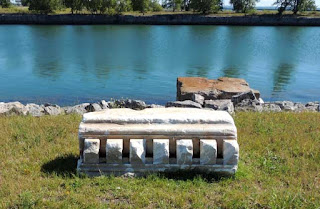This journey begins in Buffalo, New York--on its Lake Erie waterfront, to be precise--but ends in Rome. A bit of patience required.
 |
| Marble bench, Wilkeson Point |
 |
| Marbles, dumped in Lake Erie |
 |
| St. Joseph's "New Cathedral," Buffalo |
magnificent Gothic revival structure built in Buffalo at Delaware Ave. and W. Utica St., finished in 1915 and torn down in 1976.
 |
| M & T Bank, Bflo. Probable origin of the marbles. |
Others argue--with more logic, we think--that the waterfront stones were once part of the old M & T Bank building at Main and Swan streets. The bank building had fluted columns of the sort found on the waterfront, the church did not.
Regardless of their origin, they ended up as trash on the shores of Lake Erie.
While researching one problem, we came upon another, one that led us to a Rome connection. The New Cathedral was quite "young" when it was retired from service, and there is disagreement about why. Some believe that the edifice was in fine shape but that Buffalo's then Bishop, Edward D. Head, wanted it torn down so that he could build something else on the valuable and central site. Others argued that the church had begun deteriorating soon after it was built. Twin spires were taken down in 1927/28, little more than a decade after its consecration, and at great costs. Chunks of the ceiling were falling, and pews had to be cordoned off. The stones on the church's facade began to pull away from the brick wall behind them. In the 1970s, Bishop Head argued that the structure was the "victim of bad design or bad construction." One view was that the stones were poorly attached, primarily because the architect had no experience in stonework of that kind, According to one website, "descendants of the general contractor and the architect blamed each other."
 |
| Aristides Leonori |
And not just any architect. Leonori (1856-1928) was widely known as a devout Catholic. A member of the 3rd order of St. Francis, he designed the Franciscan Church and Monastery of the Holy Sepulcher in Washington, D.C., where a mosaic of his face resides. Having graduated with a degree in civil engineering, he designed buildings all over the world--in Cairo (a magnificent church), Pompeii, St. Louis, Buffalo--an important city when he worked there--and, of course, Rome.
His Rome buildings include several hospitals and at least 5 churches, among them the Irish National Church in Rome (1892), a church in the Trionfale quarter and, perhaps his best Rome work, the church known as Santa Croce in via Flaminia (1912).
Having lived in Flaminio twice, we recognized Santa Croce immediately, and were surprised by its name, because it's not on via Flaminia, but just around the corner on via Guido Reni, just a few steps from the MAXXI art gallery. It's an elegant, refined piece of work on a relatively modest scale, and
it doesn't look anything like the dramatic church he built in Buffalo just a few years later. And unlike the ill-fated Buffalo structure, this one appears to be in holding up well.
| Santa Croce in via Flaminia (except it isn't), Rome |
Bill

2 comments:
The guy's name was Aristide, not Aristides (which is the Greek spelling).
my great-great-great uncle, trank you for the Story
and greetings from Berlin,
Francesco
Post a Comment